Business Modeling for Decision Making: TV King Ltd Report
VerifiedAdded on 2023/01/09
|9
|2160
|20
Report
AI Summary
This report, focusing on business modeling for decision-making, begins with an analysis of Economic Order Quantity (EOQ) for TV King Ltd, calculating the optimal order quantity and the number of deliveries per year. It then explores the implications of a Taiwanese supplier, recalculating EOQ with adjusted costs and discussing supplier selection factors. Part 2 presents a profit equation, constructs a demand, cost, and profit table, and generates related graphs. The report identifies the maximum profit point based on the model and analyzes the strong and weak points of London and Liverpool models, offering insights into the optimal value of 'q' for maximizing profit. The report concludes by presenting a value for X and includes comprehensive references.
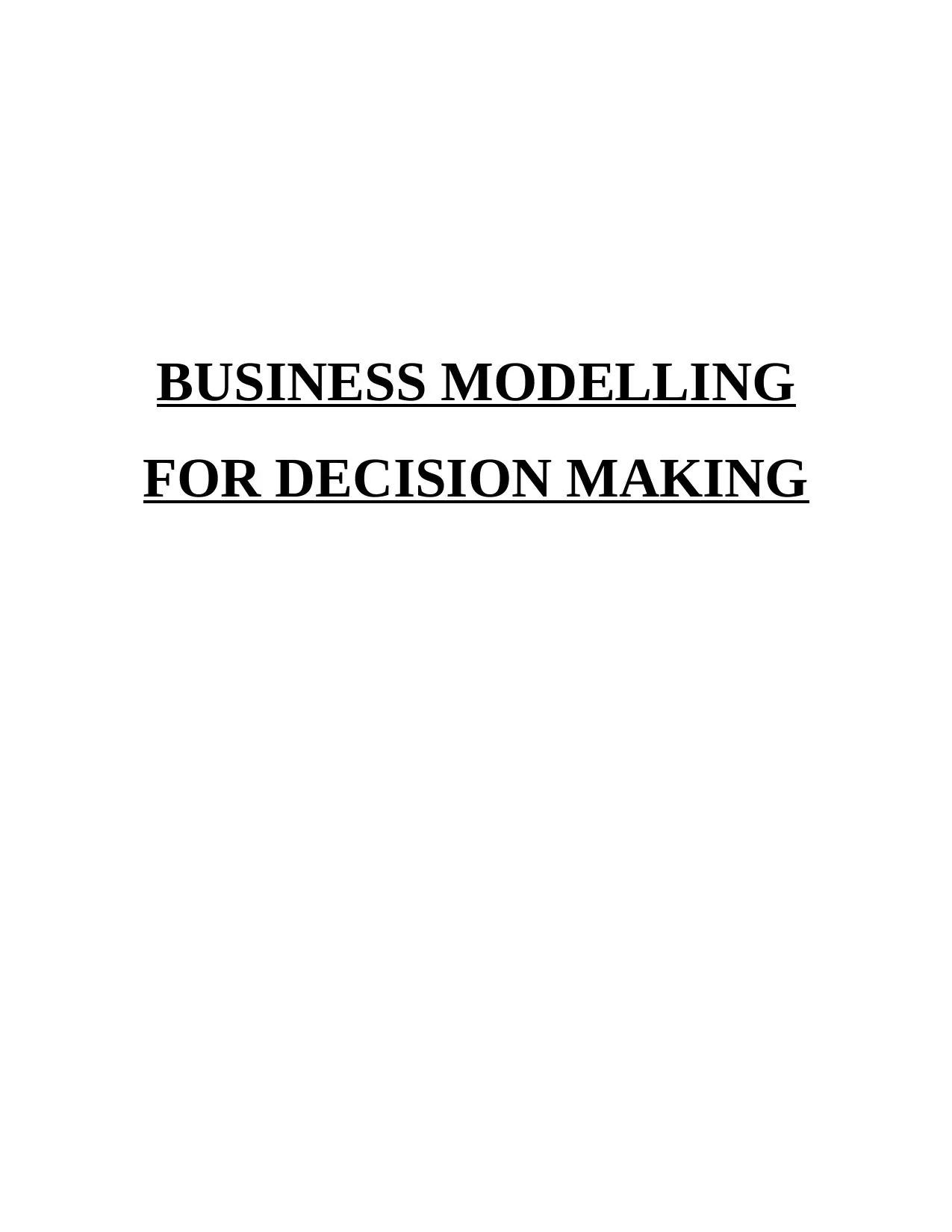
BUSINESS MODELLING
FOR DECISION MAKING
FOR DECISION MAKING
Paraphrase This Document
Need a fresh take? Get an instant paraphrase of this document with our AI Paraphraser
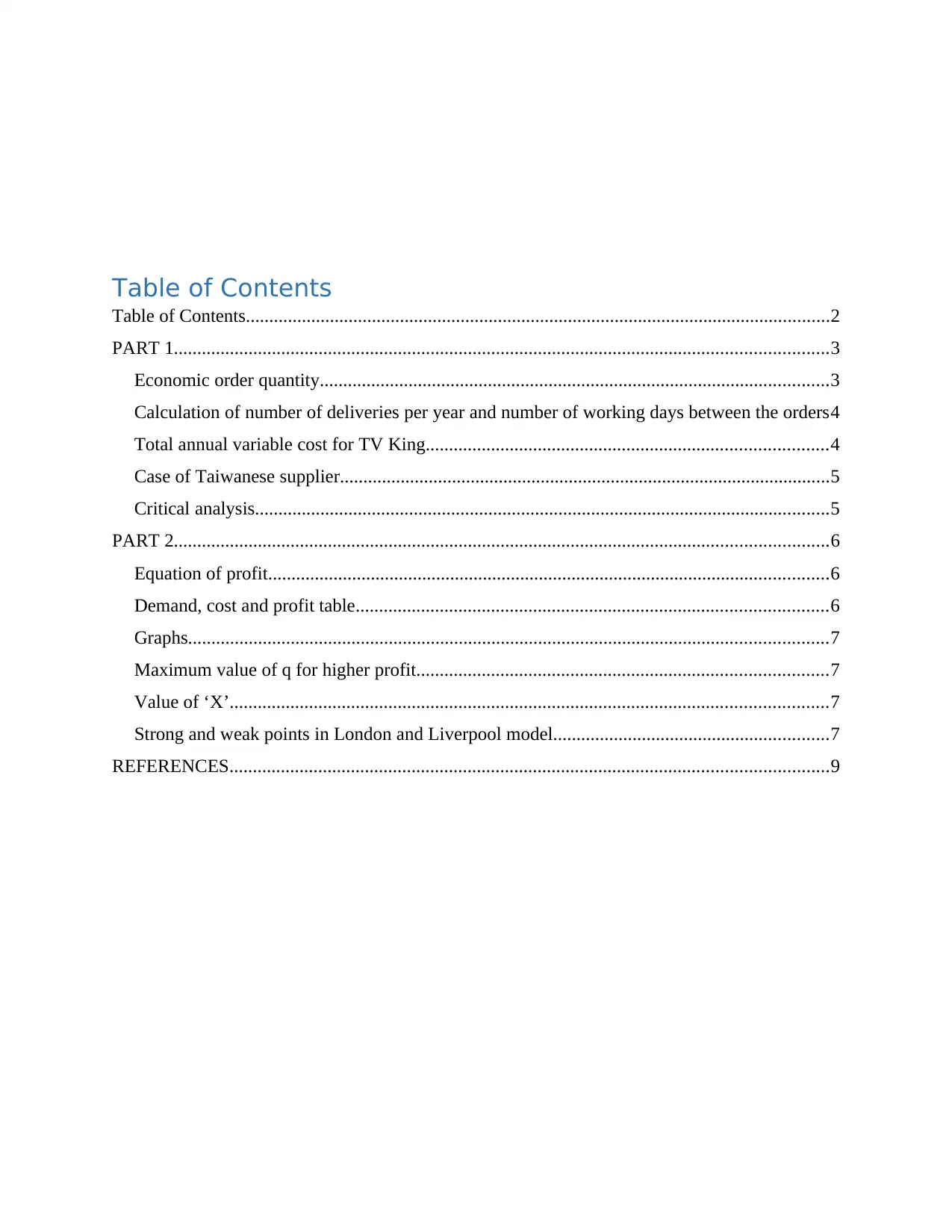
Table of Contents
Table of Contents.............................................................................................................................2
PART 1............................................................................................................................................3
Economic order quantity.............................................................................................................3
Calculation of number of deliveries per year and number of working days between the orders4
Total annual variable cost for TV King......................................................................................4
Case of Taiwanese supplier.........................................................................................................5
Critical analysis...........................................................................................................................5
PART 2............................................................................................................................................6
Equation of profit........................................................................................................................6
Demand, cost and profit table.....................................................................................................6
Graphs.........................................................................................................................................7
Maximum value of q for higher profit........................................................................................7
Value of ‘X’................................................................................................................................7
Strong and weak points in London and Liverpool model...........................................................7
REFERENCES................................................................................................................................9
Table of Contents.............................................................................................................................2
PART 1............................................................................................................................................3
Economic order quantity.............................................................................................................3
Calculation of number of deliveries per year and number of working days between the orders4
Total annual variable cost for TV King......................................................................................4
Case of Taiwanese supplier.........................................................................................................5
Critical analysis...........................................................................................................................5
PART 2............................................................................................................................................6
Equation of profit........................................................................................................................6
Demand, cost and profit table.....................................................................................................6
Graphs.........................................................................................................................................7
Maximum value of q for higher profit........................................................................................7
Value of ‘X’................................................................................................................................7
Strong and weak points in London and Liverpool model...........................................................7
REFERENCES................................................................................................................................9
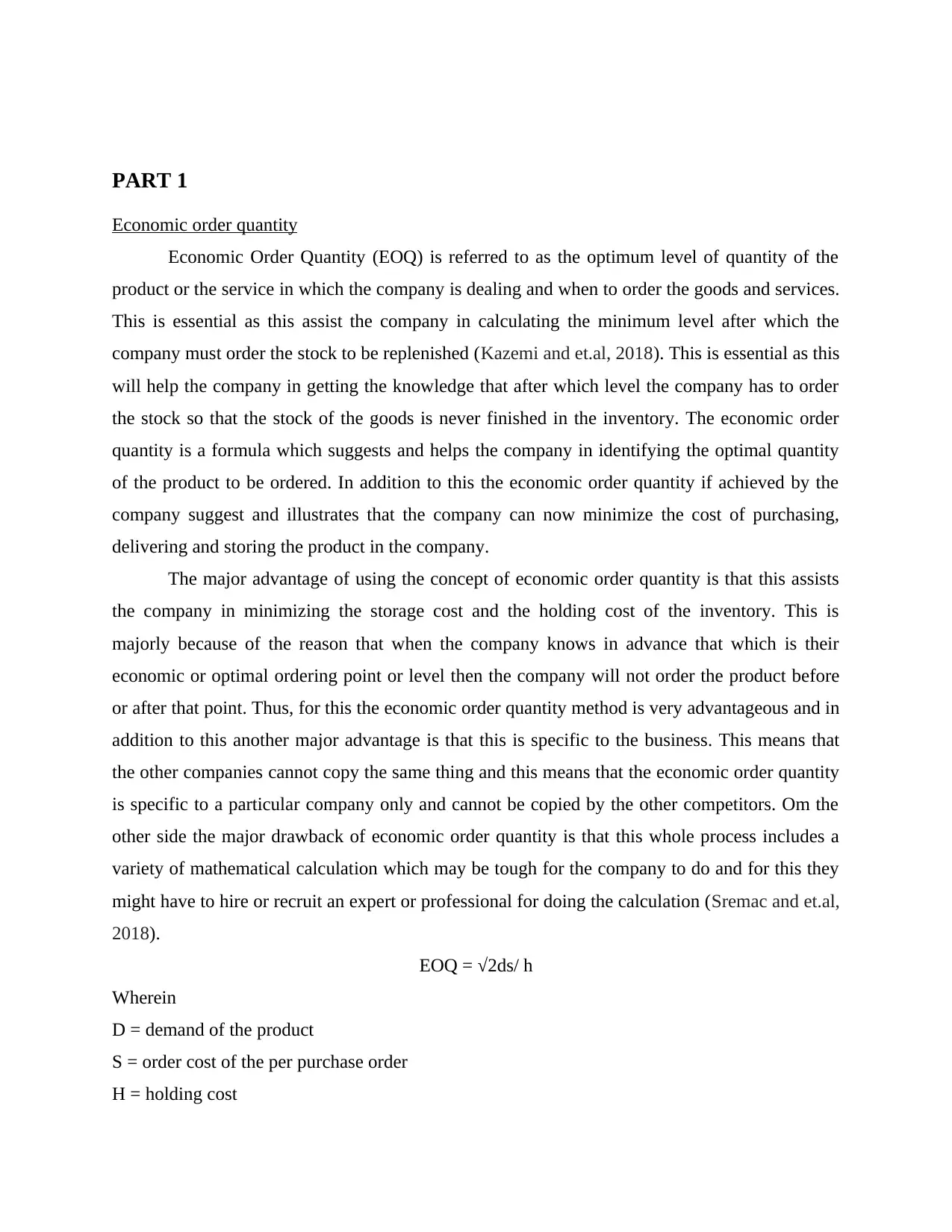
PART 1
Economic order quantity
Economic Order Quantity (EOQ) is referred to as the optimum level of quantity of the
product or the service in which the company is dealing and when to order the goods and services.
This is essential as this assist the company in calculating the minimum level after which the
company must order the stock to be replenished (Kazemi and et.al, 2018). This is essential as this
will help the company in getting the knowledge that after which level the company has to order
the stock so that the stock of the goods is never finished in the inventory. The economic order
quantity is a formula which suggests and helps the company in identifying the optimal quantity
of the product to be ordered. In addition to this the economic order quantity if achieved by the
company suggest and illustrates that the company can now minimize the cost of purchasing,
delivering and storing the product in the company.
The major advantage of using the concept of economic order quantity is that this assists
the company in minimizing the storage cost and the holding cost of the inventory. This is
majorly because of the reason that when the company knows in advance that which is their
economic or optimal ordering point or level then the company will not order the product before
or after that point. Thus, for this the economic order quantity method is very advantageous and in
addition to this another major advantage is that this is specific to the business. This means that
the other companies cannot copy the same thing and this means that the economic order quantity
is specific to a particular company only and cannot be copied by the other competitors. Om the
other side the major drawback of economic order quantity is that this whole process includes a
variety of mathematical calculation which may be tough for the company to do and for this they
might have to hire or recruit an expert or professional for doing the calculation (Sremac and et.al,
2018).
EOQ = √2ds/ h
Wherein
D = demand of the product
S = order cost of the per purchase order
H = holding cost
Economic order quantity
Economic Order Quantity (EOQ) is referred to as the optimum level of quantity of the
product or the service in which the company is dealing and when to order the goods and services.
This is essential as this assist the company in calculating the minimum level after which the
company must order the stock to be replenished (Kazemi and et.al, 2018). This is essential as this
will help the company in getting the knowledge that after which level the company has to order
the stock so that the stock of the goods is never finished in the inventory. The economic order
quantity is a formula which suggests and helps the company in identifying the optimal quantity
of the product to be ordered. In addition to this the economic order quantity if achieved by the
company suggest and illustrates that the company can now minimize the cost of purchasing,
delivering and storing the product in the company.
The major advantage of using the concept of economic order quantity is that this assists
the company in minimizing the storage cost and the holding cost of the inventory. This is
majorly because of the reason that when the company knows in advance that which is their
economic or optimal ordering point or level then the company will not order the product before
or after that point. Thus, for this the economic order quantity method is very advantageous and in
addition to this another major advantage is that this is specific to the business. This means that
the other companies cannot copy the same thing and this means that the economic order quantity
is specific to a particular company only and cannot be copied by the other competitors. Om the
other side the major drawback of economic order quantity is that this whole process includes a
variety of mathematical calculation which may be tough for the company to do and for this they
might have to hire or recruit an expert or professional for doing the calculation (Sremac and et.al,
2018).
EOQ = √2ds/ h
Wherein
D = demand of the product
S = order cost of the per purchase order
H = holding cost
⊘ This is a preview!⊘
Do you want full access?
Subscribe today to unlock all pages.

Trusted by 1+ million students worldwide
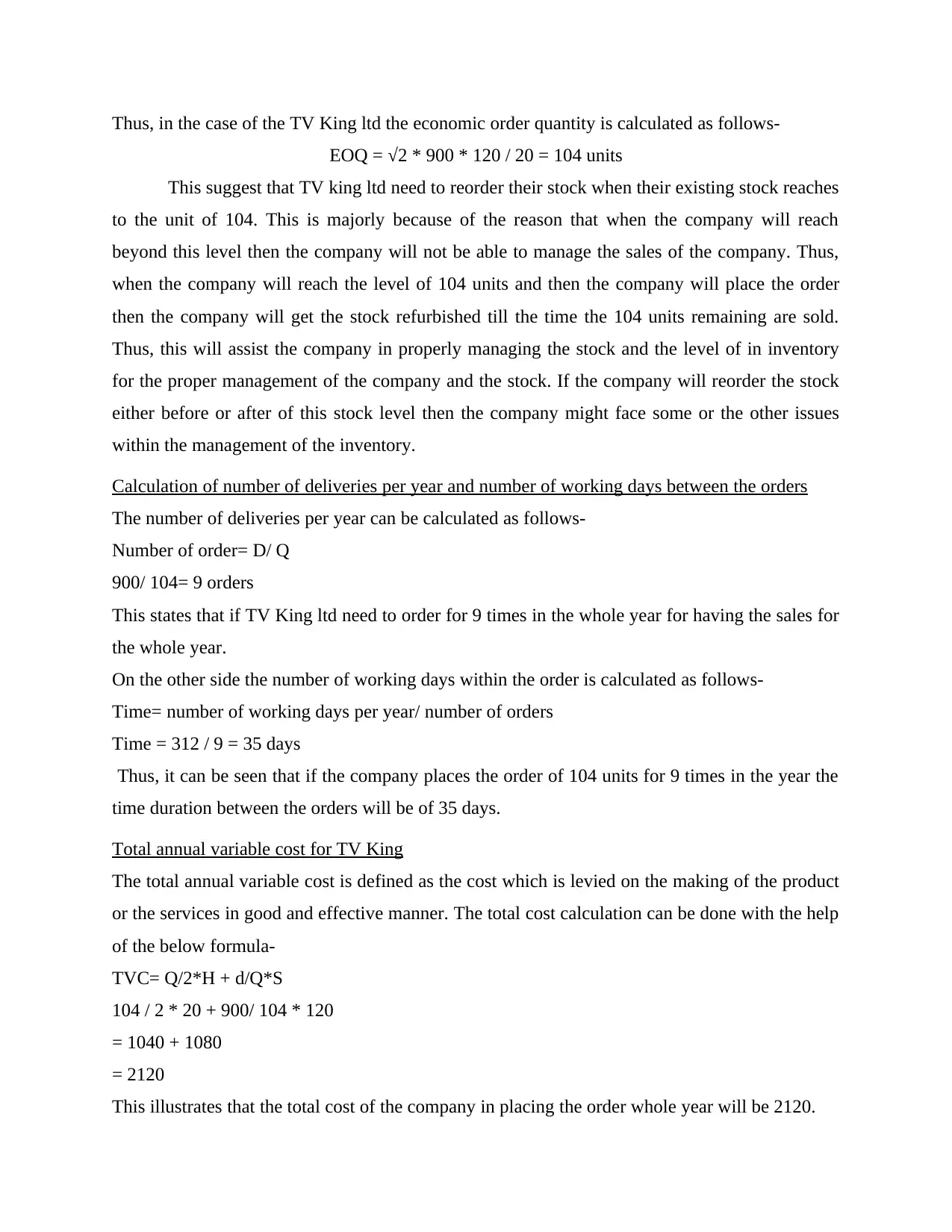
Thus, in the case of the TV King ltd the economic order quantity is calculated as follows-
EOQ = √2 * 900 * 120 / 20 = 104 units
This suggest that TV king ltd need to reorder their stock when their existing stock reaches
to the unit of 104. This is majorly because of the reason that when the company will reach
beyond this level then the company will not be able to manage the sales of the company. Thus,
when the company will reach the level of 104 units and then the company will place the order
then the company will get the stock refurbished till the time the 104 units remaining are sold.
Thus, this will assist the company in properly managing the stock and the level of in inventory
for the proper management of the company and the stock. If the company will reorder the stock
either before or after of this stock level then the company might face some or the other issues
within the management of the inventory.
Calculation of number of deliveries per year and number of working days between the orders
The number of deliveries per year can be calculated as follows-
Number of order= D/ Q
900/ 104= 9 orders
This states that if TV King ltd need to order for 9 times in the whole year for having the sales for
the whole year.
On the other side the number of working days within the order is calculated as follows-
Time= number of working days per year/ number of orders
Time = 312 / 9 = 35 days
Thus, it can be seen that if the company places the order of 104 units for 9 times in the year the
time duration between the orders will be of 35 days.
Total annual variable cost for TV King
The total annual variable cost is defined as the cost which is levied on the making of the product
or the services in good and effective manner. The total cost calculation can be done with the help
of the below formula-
TVC= Q/2*H + d/Q*S
104 / 2 * 20 + 900/ 104 * 120
= 1040 + 1080
= 2120
This illustrates that the total cost of the company in placing the order whole year will be 2120.
EOQ = √2 * 900 * 120 / 20 = 104 units
This suggest that TV king ltd need to reorder their stock when their existing stock reaches
to the unit of 104. This is majorly because of the reason that when the company will reach
beyond this level then the company will not be able to manage the sales of the company. Thus,
when the company will reach the level of 104 units and then the company will place the order
then the company will get the stock refurbished till the time the 104 units remaining are sold.
Thus, this will assist the company in properly managing the stock and the level of in inventory
for the proper management of the company and the stock. If the company will reorder the stock
either before or after of this stock level then the company might face some or the other issues
within the management of the inventory.
Calculation of number of deliveries per year and number of working days between the orders
The number of deliveries per year can be calculated as follows-
Number of order= D/ Q
900/ 104= 9 orders
This states that if TV King ltd need to order for 9 times in the whole year for having the sales for
the whole year.
On the other side the number of working days within the order is calculated as follows-
Time= number of working days per year/ number of orders
Time = 312 / 9 = 35 days
Thus, it can be seen that if the company places the order of 104 units for 9 times in the year the
time duration between the orders will be of 35 days.
Total annual variable cost for TV King
The total annual variable cost is defined as the cost which is levied on the making of the product
or the services in good and effective manner. The total cost calculation can be done with the help
of the below formula-
TVC= Q/2*H + d/Q*S
104 / 2 * 20 + 900/ 104 * 120
= 1040 + 1080
= 2120
This illustrates that the total cost of the company in placing the order whole year will be 2120.
Paraphrase This Document
Need a fresh take? Get an instant paraphrase of this document with our AI Paraphraser
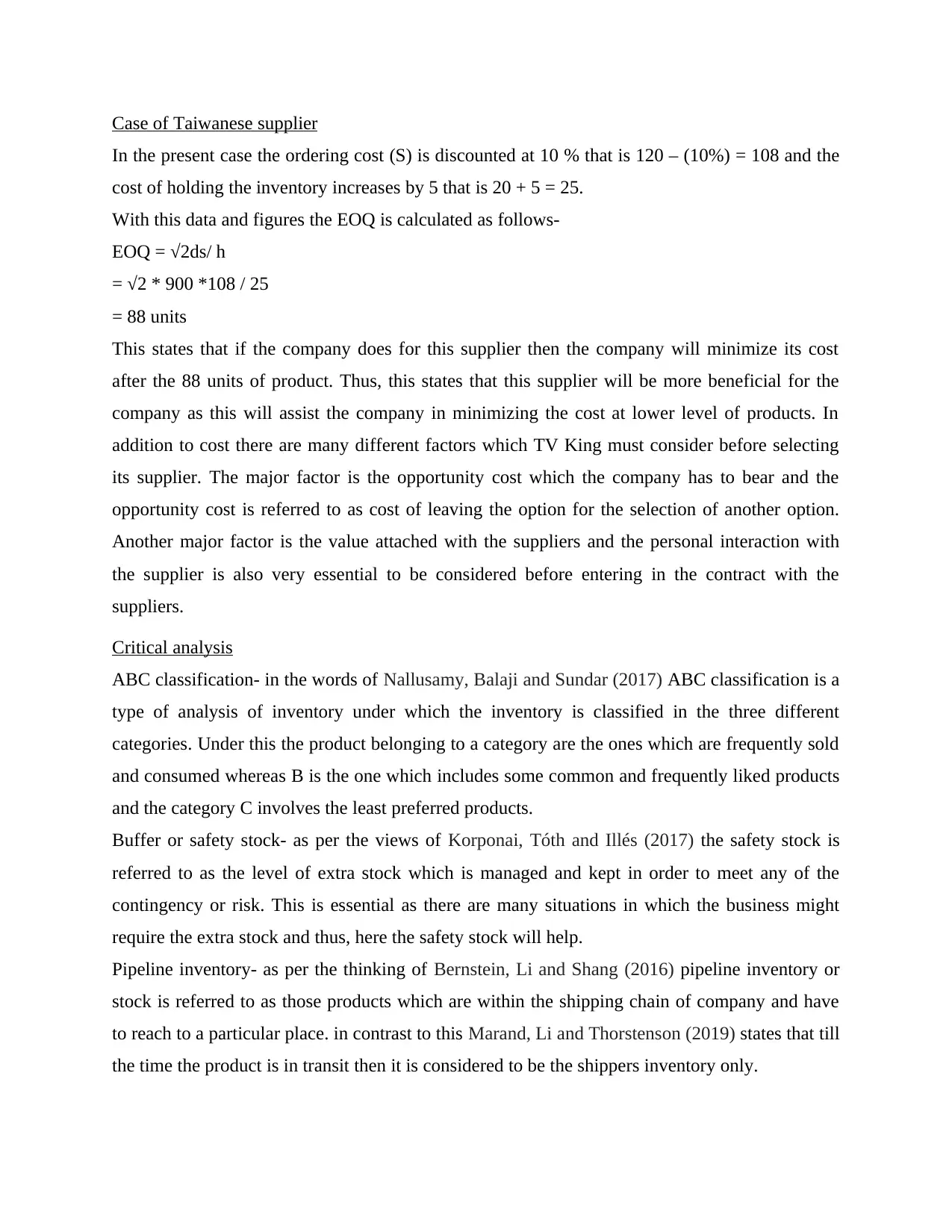
Case of Taiwanese supplier
In the present case the ordering cost (S) is discounted at 10 % that is 120 – (10%) = 108 and the
cost of holding the inventory increases by 5 that is 20 + 5 = 25.
With this data and figures the EOQ is calculated as follows-
EOQ = √2ds/ h
= √2 * 900 *108 / 25
= 88 units
This states that if the company does for this supplier then the company will minimize its cost
after the 88 units of product. Thus, this states that this supplier will be more beneficial for the
company as this will assist the company in minimizing the cost at lower level of products. In
addition to cost there are many different factors which TV King must consider before selecting
its supplier. The major factor is the opportunity cost which the company has to bear and the
opportunity cost is referred to as cost of leaving the option for the selection of another option.
Another major factor is the value attached with the suppliers and the personal interaction with
the supplier is also very essential to be considered before entering in the contract with the
suppliers.
Critical analysis
ABC classification- in the words of Nallusamy, Balaji and Sundar (2017) ABC classification is a
type of analysis of inventory under which the inventory is classified in the three different
categories. Under this the product belonging to a category are the ones which are frequently sold
and consumed whereas B is the one which includes some common and frequently liked products
and the category C involves the least preferred products.
Buffer or safety stock- as per the views of Korponai, Tóth and Illés (2017) the safety stock is
referred to as the level of extra stock which is managed and kept in order to meet any of the
contingency or risk. This is essential as there are many situations in which the business might
require the extra stock and thus, here the safety stock will help.
Pipeline inventory- as per the thinking of Bernstein, Li and Shang (2016) pipeline inventory or
stock is referred to as those products which are within the shipping chain of company and have
to reach to a particular place. in contrast to this Marand, Li and Thorstenson (2019) states that till
the time the product is in transit then it is considered to be the shippers inventory only.
In the present case the ordering cost (S) is discounted at 10 % that is 120 – (10%) = 108 and the
cost of holding the inventory increases by 5 that is 20 + 5 = 25.
With this data and figures the EOQ is calculated as follows-
EOQ = √2ds/ h
= √2 * 900 *108 / 25
= 88 units
This states that if the company does for this supplier then the company will minimize its cost
after the 88 units of product. Thus, this states that this supplier will be more beneficial for the
company as this will assist the company in minimizing the cost at lower level of products. In
addition to cost there are many different factors which TV King must consider before selecting
its supplier. The major factor is the opportunity cost which the company has to bear and the
opportunity cost is referred to as cost of leaving the option for the selection of another option.
Another major factor is the value attached with the suppliers and the personal interaction with
the supplier is also very essential to be considered before entering in the contract with the
suppliers.
Critical analysis
ABC classification- in the words of Nallusamy, Balaji and Sundar (2017) ABC classification is a
type of analysis of inventory under which the inventory is classified in the three different
categories. Under this the product belonging to a category are the ones which are frequently sold
and consumed whereas B is the one which includes some common and frequently liked products
and the category C involves the least preferred products.
Buffer or safety stock- as per the views of Korponai, Tóth and Illés (2017) the safety stock is
referred to as the level of extra stock which is managed and kept in order to meet any of the
contingency or risk. This is essential as there are many situations in which the business might
require the extra stock and thus, here the safety stock will help.
Pipeline inventory- as per the thinking of Bernstein, Li and Shang (2016) pipeline inventory or
stock is referred to as those products which are within the shipping chain of company and have
to reach to a particular place. in contrast to this Marand, Li and Thorstenson (2019) states that till
the time the product is in transit then it is considered to be the shippers inventory only.

Inventory system- in contrast to above Pazhani, Ventura and Mendoza, (2016) argues that the
inventory system is a system which makes sure that the company is taking care of the stock since
the time it is ordered till the time the inventory is converted in the finished goods and made
available to the consumer for the end consumption.
PART 2
Equation of profit
Profit = total revenue- total cost
(200- 15q) – (120 + [(-8q) + 12q2])
Demand, cost and profit table
Value of q Demand (200- 15q) Cost (120 + [(8q +
12q2)
Profit= demand – cost
0 200 120 80
1 185 140 45
2 170 184 (14)
3 155 252 (97)
4 140 344 (204)
5 125 460 (335)
6 110 600 (490)
Thus, from the above table it is clear that as the demand of the product decreases the cost of the
company increases and these results in loss of the company. This is not a good condition for the
company as this will have a great impact over the working of the company and the profitability
of the company as well.
inventory system is a system which makes sure that the company is taking care of the stock since
the time it is ordered till the time the inventory is converted in the finished goods and made
available to the consumer for the end consumption.
PART 2
Equation of profit
Profit = total revenue- total cost
(200- 15q) – (120 + [(-8q) + 12q2])
Demand, cost and profit table
Value of q Demand (200- 15q) Cost (120 + [(8q +
12q2)
Profit= demand – cost
0 200 120 80
1 185 140 45
2 170 184 (14)
3 155 252 (97)
4 140 344 (204)
5 125 460 (335)
6 110 600 (490)
Thus, from the above table it is clear that as the demand of the product decreases the cost of the
company increases and these results in loss of the company. This is not a good condition for the
company as this will have a great impact over the working of the company and the profitability
of the company as well.
⊘ This is a preview!⊘
Do you want full access?
Subscribe today to unlock all pages.

Trusted by 1+ million students worldwide
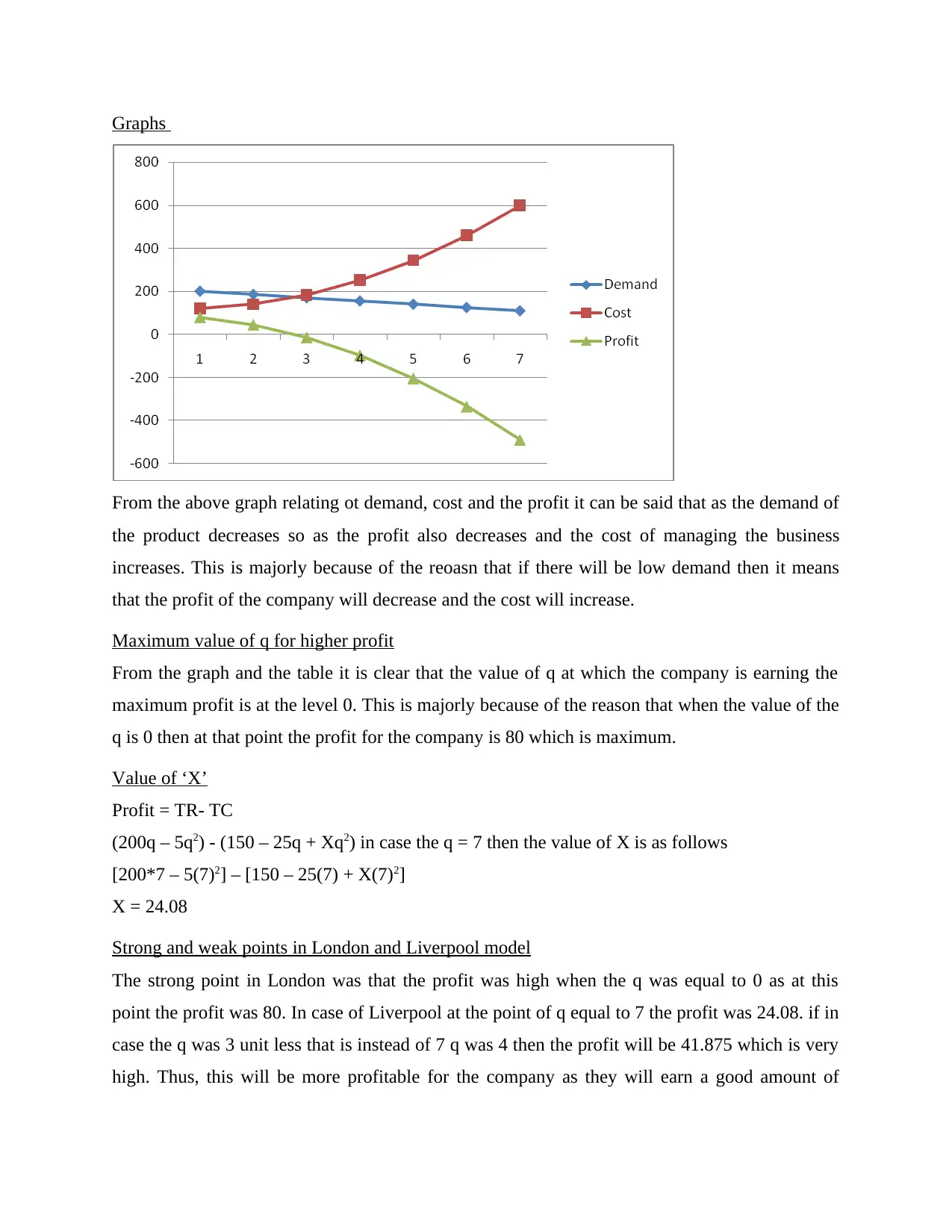
Graphs
From the above graph relating ot demand, cost and the profit it can be said that as the demand of
the product decreases so as the profit also decreases and the cost of managing the business
increases. This is majorly because of the reoasn that if there will be low demand then it means
that the profit of the company will decrease and the cost will increase.
Maximum value of q for higher profit
From the graph and the table it is clear that the value of q at which the company is earning the
maximum profit is at the level 0. This is majorly because of the reason that when the value of the
q is 0 then at that point the profit for the company is 80 which is maximum.
Value of ‘X’
Profit = TR- TC
(200q – 5q2) - (150 – 25q + Xq2) in case the q = 7 then the value of X is as follows
[200*7 – 5(7)2] – [150 – 25(7) + X(7)2]
X = 24.08
Strong and weak points in London and Liverpool model
The strong point in London was that the profit was high when the q was equal to 0 as at this
point the profit was 80. In case of Liverpool at the point of q equal to 7 the profit was 24.08. if in
case the q was 3 unit less that is instead of 7 q was 4 then the profit will be 41.875 which is very
high. Thus, this will be more profitable for the company as they will earn a good amount of
From the above graph relating ot demand, cost and the profit it can be said that as the demand of
the product decreases so as the profit also decreases and the cost of managing the business
increases. This is majorly because of the reoasn that if there will be low demand then it means
that the profit of the company will decrease and the cost will increase.
Maximum value of q for higher profit
From the graph and the table it is clear that the value of q at which the company is earning the
maximum profit is at the level 0. This is majorly because of the reason that when the value of the
q is 0 then at that point the profit for the company is 80 which is maximum.
Value of ‘X’
Profit = TR- TC
(200q – 5q2) - (150 – 25q + Xq2) in case the q = 7 then the value of X is as follows
[200*7 – 5(7)2] – [150 – 25(7) + X(7)2]
X = 24.08
Strong and weak points in London and Liverpool model
The strong point in London was that the profit was high when the q was equal to 0 as at this
point the profit was 80. In case of Liverpool at the point of q equal to 7 the profit was 24.08. if in
case the q was 3 unit less that is instead of 7 q was 4 then the profit will be 41.875 which is very
high. Thus, this will be more profitable for the company as they will earn a good amount of
Paraphrase This Document
Need a fresh take? Get an instant paraphrase of this document with our AI Paraphraser
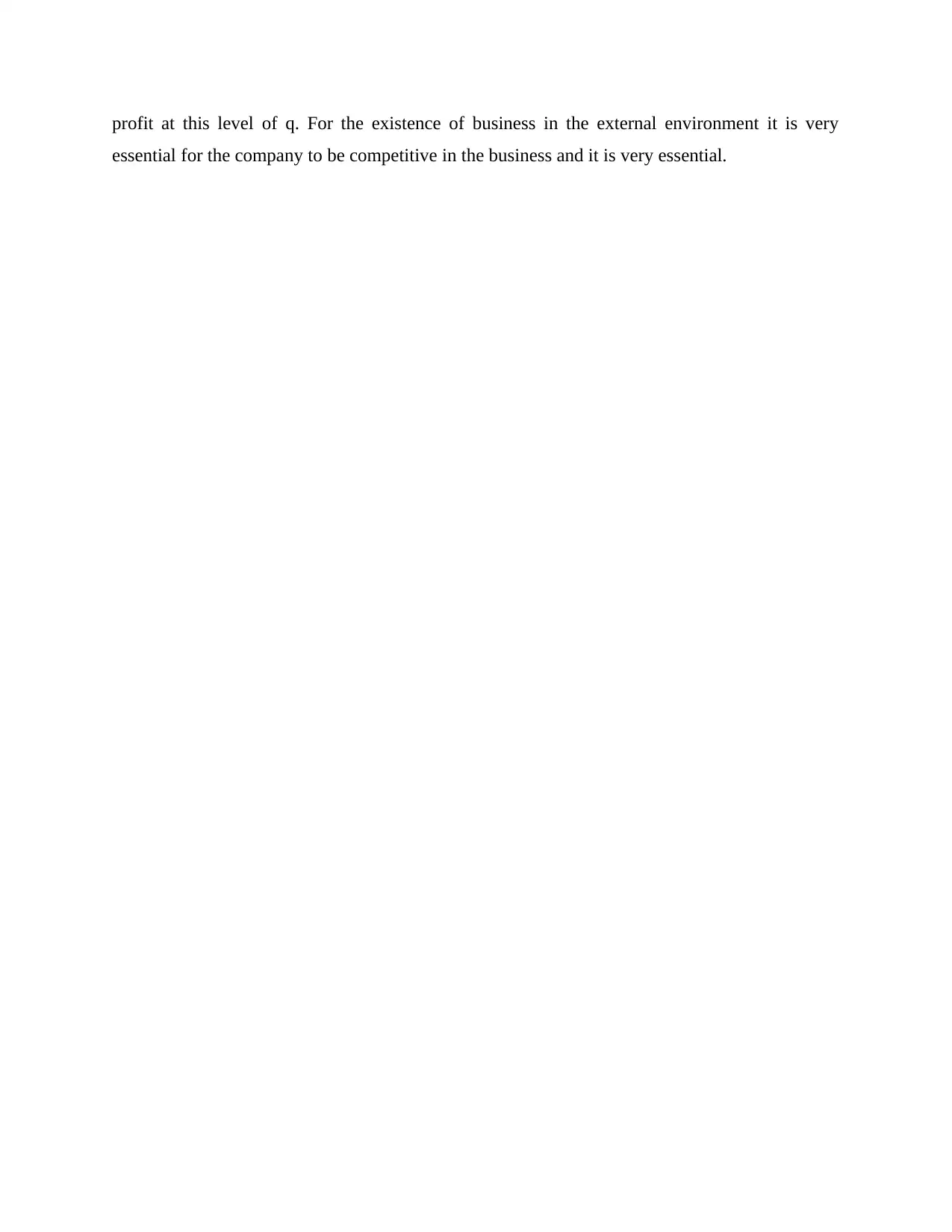
profit at this level of q. For the existence of business in the external environment it is very
essential for the company to be competitive in the business and it is very essential.
essential for the company to be competitive in the business and it is very essential.

REFERENCES
Books and Journals
Bernstein, F., Li, Y. and Shang, K., 2016. A simple heuristic for joint inventory and pricing
models with lead time and backorders. Management Science. 62(8). pp.2358-2373.
Kazemi, N., and et.al, 2018. Economic order quantity models for items with imperfect quality
and emission considerations. International Journal of Systems Science: Operations &
Logistics, 5(2). pp.99-115.
Korponai, J., Tóth, Á.B. and Illés, B., 2017. Effect of the Safety Stock on the Probability of
Occurrence of the Stock Shortage. Procedia Engineering. 182. pp.335-341.
Marand, A.J., Li, H. and Thorstenson, A., 2019. Joint inventory control and pricing in a service-
inventory system. International Journal of Production Economics. 209. pp.78-91.
Nallusamy, S., Balaji, R. and Sundar, S., 2017. Proposed model for inventory review policy
through ABC analysis in an automotive manufacturing industry. In International
Journal of Engineering Research in Africa (Vol. 29, pp. 165-174). Trans Tech
Publications Ltd.
Pazhani, S., Ventura, J.A. and Mendoza, A., 2016. A serial inventory system with supplier
selection and order quantity allocation considering transportation costs. Applied
Mathematical Modelling. 40(1). pp.612-634.
Sremac, S., and et.al, 2018. ANFIS model for determining the economic order quantity. Decision
Making: Applications in Management and Engineering. 1(2). pp.81-92.
Books and Journals
Bernstein, F., Li, Y. and Shang, K., 2016. A simple heuristic for joint inventory and pricing
models with lead time and backorders. Management Science. 62(8). pp.2358-2373.
Kazemi, N., and et.al, 2018. Economic order quantity models for items with imperfect quality
and emission considerations. International Journal of Systems Science: Operations &
Logistics, 5(2). pp.99-115.
Korponai, J., Tóth, Á.B. and Illés, B., 2017. Effect of the Safety Stock on the Probability of
Occurrence of the Stock Shortage. Procedia Engineering. 182. pp.335-341.
Marand, A.J., Li, H. and Thorstenson, A., 2019. Joint inventory control and pricing in a service-
inventory system. International Journal of Production Economics. 209. pp.78-91.
Nallusamy, S., Balaji, R. and Sundar, S., 2017. Proposed model for inventory review policy
through ABC analysis in an automotive manufacturing industry. In International
Journal of Engineering Research in Africa (Vol. 29, pp. 165-174). Trans Tech
Publications Ltd.
Pazhani, S., Ventura, J.A. and Mendoza, A., 2016. A serial inventory system with supplier
selection and order quantity allocation considering transportation costs. Applied
Mathematical Modelling. 40(1). pp.612-634.
Sremac, S., and et.al, 2018. ANFIS model for determining the economic order quantity. Decision
Making: Applications in Management and Engineering. 1(2). pp.81-92.
⊘ This is a preview!⊘
Do you want full access?
Subscribe today to unlock all pages.

Trusted by 1+ million students worldwide
1 out of 9
Related Documents
Your All-in-One AI-Powered Toolkit for Academic Success.
+13062052269
info@desklib.com
Available 24*7 on WhatsApp / Email
![[object Object]](/_next/static/media/star-bottom.7253800d.svg)
Unlock your academic potential
Copyright © 2020–2025 A2Z Services. All Rights Reserved. Developed and managed by ZUCOL.





